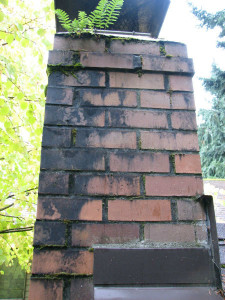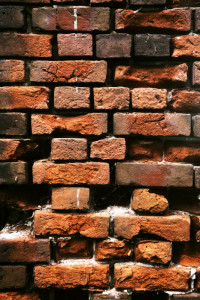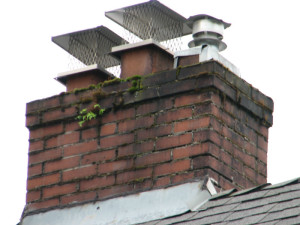by Billy Sweet | Dec 26, 2015 | Creosote
If you have a fireplace, you likely know that creosote can be a hazard to your home and family. You probably also have your fireplace swept by a certified chimney sweep each year to remove any creosote buildup from your chimney, and perhaps you even burn the occasional creosote sweeping log to help maintain your chimney. But how much do you know about creosote, how it forms, the dangers it poses and how you can keep it at bay? We’ve put together some basic information on creosote so you can better protect your home and family.

What is creosote?
As smoke from your fireplace makes its way to the top of your chimney, it cools. As the smoke cools, it causes condensation of the chemicals and water vapor created when wood burns. The substance left sticking to your walls is creosote. All forms of creosote — whether black or brown, sticky or shiny, hard or tar like — can be found sticking to the insides of most chimneys.
Why is creosote dangerous?
As little as a quarter inch of creosote buildup on the walls of your chimney can be dangerous, putting your home at risk of a chimney fire. Highly combustible, creosote can burst into flames if it is touched by a stray spark from your fireplace, or if chimney temperatures exceed 1,000 degrees. If creosote builds up enough in your chimney, it also can prevent the gases created by the fireplace from exiting your home, which can force dangerous carbon monoxide back into your home.
How can I avoid the dangers of creosote?
Using the right wood in your fireplace can slow the buildup of creosote in your chimney. Only burn dry hardwoods that have been seasoned for a minimum of six months. When wood is improperly seasoned and contains moisture, it produces more water vapor when burned and burns at a cooler temperature, which causes the formation of creosote. Make sure that your fire is large enough for your fireplace. If your logs are too small, the fire won’t burn hot enough for your chimney. Your flue also should be fully opened when you’re burning a fire, as a partially closed flue will cause smoke to remain in your flue longer, encouraging creosote buildup.
Of course, the best way to keep your home safe from a creosote fire is to have your chimney swept and inspected each year by a certified chimney sweep. Your chimney sweep will make sure that your chimney is entirely creosote free. During the sweep’s inspection, he also will make sure your chimney does not show any signs of damage from a past creosote fire, which can weaken your chimney and put your home at danger for a future fire.
If you’re overdue for a chimney sweeping and inspection, don’t wait! Putting off your chimney sweeping puts your home and family in danger of a creosote-caused chimney fire or carbon monoxide poisoning. Call the certified sweeps at Billy Sweet to have your chimney ready for the fire-burning season.
by Billy Sweet | Dec 13, 2015 | Winter Storm Fireplace
In Boston, we are used to heavy snowstorms and blizzards during the winter. In January and February of 2015, we experienced a blizzard that lasted over six weeks and dumped a record 108.6 inches of snow in our area. Even though long-time residents know how to be ready for these types of storms, Billy Sweet Chimney Sweep would like to remind you of how you can prepare your fireplace so that you will not have to worry about being without heat when the power goes out during a blizzard.

Schedule a professional chimney sweeping and inspection before winter arrives.
This maintenance task will take care of removing all of the accumulated creosote from the inner walls of your chimney, which increases fireplace safety and reduces fire hazards. During the inspection, our Chimney Safety Institute of America (CSIA)-certified chimney sweeps will examine the condition of your fireplace and chimney to be sure everything is working safely. If we find any damage, we will make recommendations of the repairs that are necessary for you to use your fireplace safely.
Check the gaskets to see if they need to be repaired or replaced.
You want to ensure that the gaskets on your fireplace doors, damper, and ash dump are providing an effective seal. According to Cabin Living, without a proper seal, too much air can leak into the firebox and cause overfire and permanent damage to your fireplace.
Have the blower cleaned.
If your fireplace is equipped with a blower, you should clean off the dust and dirt from it to protect the balance of the blower. When the blower has too much dust accumulation on its blades, the balance can change and cause the bearings to wear out prematurely. Your fireplace blower typically will not have a filter to keep dust off, so you need to check it regularly to be sure it is clean.
Replace broken or deteriorated bricks in the lining.
When the brick lining is so damaged that it has deteriorated so much that the steel body of the firebox is exposed, the high temperatures can lead to permanent damage. Be sure the bricks are in good shape so you will not have to worry about damage occurring that could make your fireplace unsafe.
Billy Sweet Chimney Sweep is here to help you prepare your fireplace for dangerous storms this winter. Contact us to schedule an appointment for a chimney sweeping and inspection so that you can stay warm and safe this winter.
by Billy Sweet | Aug 24, 2015 | Chimney Discoloration
Keeping your chimney clean and healthy with regular sweeping and inspections is something that we encourage everyone to do, and not doing so can lead to some really nasty developments later on in your chimney’s life. Because the masonry of your chimney is porous, meaning it allows water to be absorbed and released through small holes, water can often get trapped and degrade the brick, as well as the inner chimney lining. The moisture provides perfect conditions for mold to flourish, and as it develops, could eventually lead to mold developing in your home. Along with mold, a substance known as efflorescence develops, which is also due to high moisture.

Efflorescence:
It’s easy to confuse mold and efflorescence growth on a chimney because they look so similar. They can come in colors of white, brown, green, or yellow, or even a combination. But unlike mold, efflorescence is actually just a response to water moving around in the masonry. The freezing and melting of water over time causes the salts in the brick to shift, causing visible patches of salt in various colors. The color composition results from other minerals like manganese and magnesium that create brown and greenish stains, respectively.
Mold:
Compared to efflorescence, mold is even more damaging because it can infect your home and your well being. With a characteristic musty smell, you may also notice peeling paint or cracks developing on your walls. These signs are dangerous and mean that the mold has spread from the masonry of your chimney, down the inner lining, and into your home. Mold can cause problems with your health over time, causing respiratory problems like congestion, coughing, and irritation. Even if you don’t see signs of mold in your home, if you begin to have these symptoms, see a doctor immediately, and then call us so that we can evaluate the damage.
What can I do to stop discoloration?
For efflorescence, the real problem isn’t the discoloration, it’s the moisture that will eventually render your chimney unusable and damage your home. Mold can threaten your home and your health, so treating this should be a much more sensitive and thorough issue. If you see discoloration on your chimney walls, the first step is ensuring it hasn’t affected your well being or that of your house. Once that is determined, the solution is finding where the moisture is coming from that is causing the discoloration. In some cases, it is an improperly sealed or cracked chimney. Other times a cap is missing that will keep water from seeping into the walls. Either way, keeping up with regular maintenance is absolutely necessary to keep this from happening. If you see mold, efflorescence, or any discoloration on your chimney, call us immediately!
by Billy Sweet | Jul 26, 2015 | Winter Masonry Damage
As summer begins to quickly fade away, it’s time now to bring attention to your chimney before winter is upon us. Among all the repairs and other activities associated with the warmer summer months, it is hard to think about preparing the upcoming winter. That feeling is completely understandable! However, there are a few reasons why you should focus some attention on your chimney at this time of the year.

Why should I have to get it repaired?
Your chimney, built in the masonry style, is built of porous materials such as concrete, brick, mortar, and stone. Think of it similar to a sponge in the way they hold water. Though they appear to stand the test of time, without proper care they can begin to crack as the processes of freezing and thawing expands, and then contracts, the masonry. Over time this leads to bricks loosening, and eventually the entire chimney will collapse. As you can tell, winter can be very hard on your chimney. With the addition of intense use of your fireplace during those months, it can amass a variety of problems… that are then ignored over the summer months as it goes unused. It is a vicious cycle!
Besides the expansion and contraction that occurs when water freezes and then thaws in the masonry, water also causes a lot of damage and deterioration to any metal or wood materials that it accesses on the interior of your chimney and in your fireplace such as:
- Dampers
- Flue lining system
- Proximal wood flooring and wall coverings
- Fireplace accessories
What can I do about it?
Chimney Caps:
Preventing water from damaging your chimney is absolutely essential for the long life of your chimney. Well-designed chimney caps are made of enduring, reliable material that can resist corrosion as well as keep birds and other animals out and off of your chimney. Though there are options that only provide partial coverage, a full coverage chimney cap is an investment that will provide the most protection long-term.
Tuckpointing:
For masonry that does lose mortar during the hard winter months due to temperature fluctuation, tuckpointing is a relatively simple process of tucking mortar into damaged areas. Not only does it reinforce the structure of your chimney, but it is more aesthetically pleasing as well.
Chimney Crown Replacement/Repair:
The crown is absolutely essential in directing water away from the flue and to the edge of the chimney so that it won’t erode any mortar or brick. If your crown is cracked or damaged in any way, the rate of chimney degradation gets increasingly higher.
Chimney Waterproofing:
We have learned that water is very damaging to both the exterior and interior of your chimney. Using a waterproofing treatment is a preventative measure against many of the above issues, as well as allows your chimney to release water vapors that it contains in the masonry while keeping additional water out.
Make your appointment online with us and learn more about your chimney at billysweetchimneysweep.com.
by Billy Sweet | Jul 6, 2015 | Capped Chimney
When you consider the safety and efficiency of your fireplace unit, you might forget one of its most important elements: your chimney cap. Many homeowners and consumers fail to recognize the vital protective measures offered by a functioning chimney cap; they might also be unfamiliar with the tell-tale signs of an issue with their caps.
A chimney cap is a small, relatively inexpensive addition to your home’s fireplace system, yet offers an important degree of protection from various threats.
A chimney cap prevents critters, wind-borne debris, moisture and other elements from entering your chimney and home. It also prevents burning embers from escaping through your chimney and landing on your roof, causing a potential fire. It’s important to ensure that your chimney cap is in proper working order before colder weather arrives.

Here are a few signs that your chimney cap needs repair or replacement.
Moisture
Moisture causes more damage to fireplaces each year than mismanaged fires, and, left unchecked, has the potential to cause serious, irreparable damage to your unit and home.
If you notice dripping or pooling water in or around your fireplace, moisture has gained an access point in your chimney, and you need an immediate inspection. A working chimney cap will prevent excess moisture from accumulating in your chimney and home.
Drafting Problems
If you notice that your chimney isn’t venting properly or is sending excess smoke into your home, you might have a broken chimney cap that is allowing blockages to build up in your flue.
If your chimney cap becomes clogged with creosote or debris, it won’t vent properly and will send smoke and particulates from the burning fire back into your home.
There are many dangers attached breathing this contaminated air, including smoke damage to your home and severe illness.
Critters or Debris Entering Your Fireplace
Another of the main functions of your chimney cap is to prevent animals or debris from entering your chimney and causing blockages or creating disturbances in your home.
Squirrels, raccoons and birds will often mistake an uncapped or open chimney for a hollow tree; they often get stuck inside the chimney or decide to build a nest in the space, creating a very dangerous situation for themselves and the homeowners.
If you hear frantic scratching or clawing in your fireplace, you may have an issue with a trapped or nesting animal. This is a sign that you chimney cap has significant damage and needs to be replaced or repaired.
Additionally, if you notice leaves, sticks or other debris gathering in your fireplace, your chimney cap is not working properly and needs to be repaired or replaced.
Ensuring That Your Chimney Cap Is In Working Order
If you’ve noticed any of these issues with your fireplace, it’s important that you have your chimney cap inspected by a professional.
A certified chimney inspector will ensure that your chimney cap is in working order, that there are no issues with venting and that you can safely use your fireplace without fear of hazards.
It is recommended that you have your chimney inspected once a year by a certified chimney sweep. Because fall is the most popular time for chimney inspections, you might consider making your appointment before the rush, to avoid delays or wait times.
Billy Sweet Chimney Sweep serves all of the Boston area with professional, certified chimney inspection and installation services.
Call today for an appointment.





